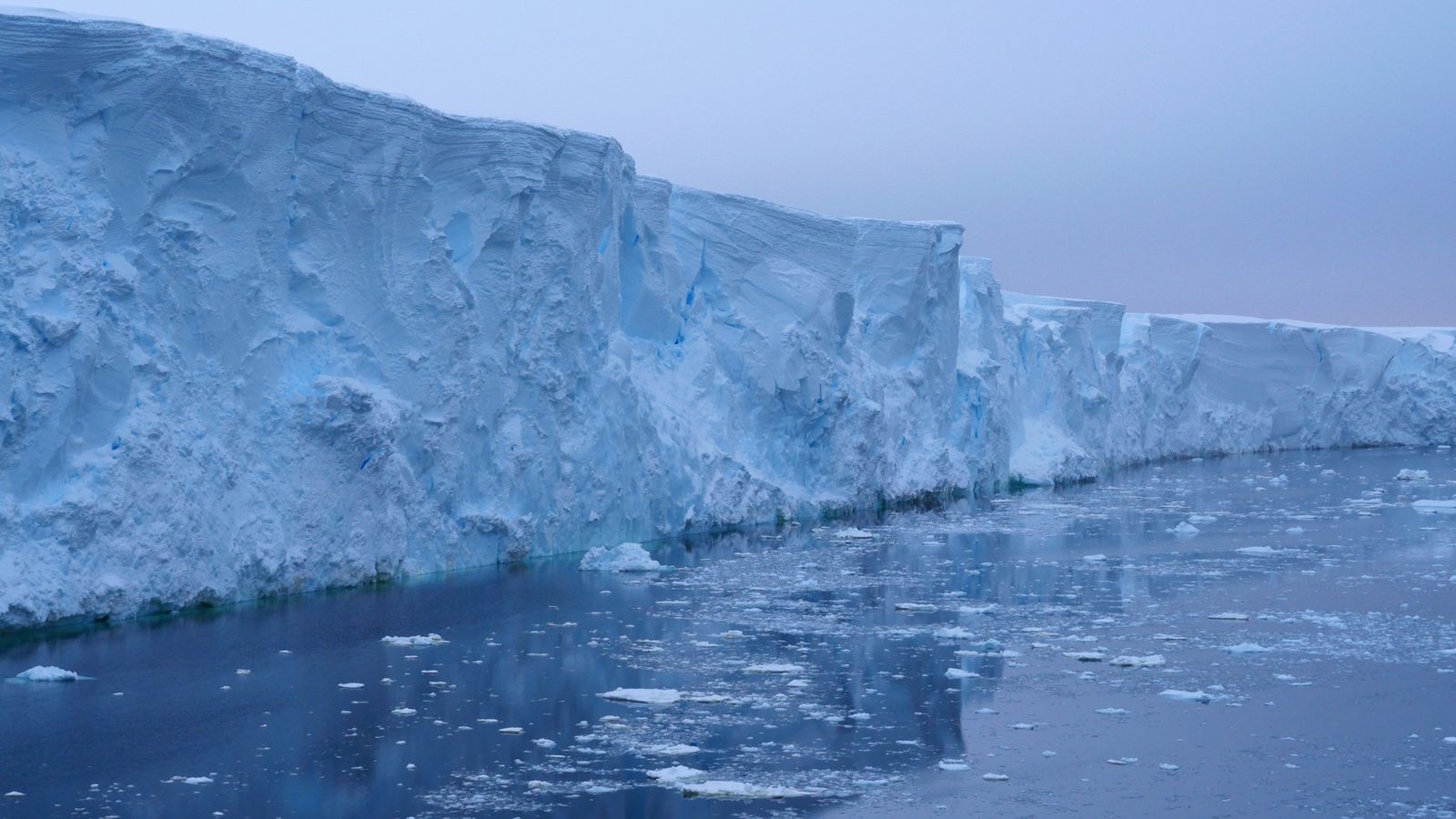The drastic idea has been praised by some scientists as “highly aspirational”, while others have branded it “dangerous, illusionary and distracting”.
By Victoria Seabrook, Climate reporter @SeabrookClimate
Scientists are designing a radical 62-mile long curtain to protect Antarctica’s so-called “doomsday” Thwaites Glacier from melting.
The largest glacier on Earth is nicknamed the “doomsday” glacier because it would drastically drive up sea levels around the world if it melted entirely, though this would take hundreds of years.
But the Britain-sized glacier is already melting, responsible for around 4% of all global sea-level rise, according to a 2020 study in Nature Geoscience.
Last year a group of scientists tasked by the UK Foreign Office to investigate “unprecedented” changes in Antarctica warned the disruption was not being taken seriously enough.
As humans continue to emit greenhouse gases that warm the climate and oceans, the race is on to protect Thwaites Glacier.
John Moore, a glaciologist at Lapland University, is working on a drastic idea that has divided scientists.
He hypothesises a giant underwater curtain could protect the glacier from being nibbled away by warm water beneath it, as it floats on the sea surface.
The curtain would be about 100m tall and pinned to the seabed.
The idea is in its infancy and is currently only being tested through relatively cheap and small scale testing in a laboratory at Cambridge University’s Centre for Climate Repair.
Will it work?
“Honestly, we do not know – the research is at an early stage,” said Prof Moore. But one model suggests it could slow the melt rate, he said.
Dr Shaun Fitzgerald from Cambridge University said they were not proposing the “deployment of these things today”, but “further research… so that we can make more informed decisions as to whether these should be deployed or not”.
“At the moment, we don’t have the armoury of knowledge,” he told Sky News.
The price tag is estimated at $50-100bn (£39-78bn), plus at least an extra $1bn (£784m) annually for maintenance.
The researchers argue the eye-watering price tag should be set in context with the costs of protecting global coastlines if the ice collapses: about $40b per year, per metre of sea level rise, and of relocating people who would lose their homes or jobs.
‘Dangerous, illusionary, distracting’
But Martin Siegert, professor of geosciences at Exeter University, called such geoengineering concepts “nonsense”.
“They are unproven. Would cost a fortune. Won’t actually work. Cause immeasurable damage to the natural systems. Are blind to governance and environmental protocols, especially in the Antarctic,” Prof Siegert said.
“These ideas are dangerous, illusionary and distracting.”
Dr Bethan Davies, senior lecturer in physical geography at Newcastle University, said building on the sea floor in an icy polar environment would be “astronomically challenging”.
Dr Robert Larter, a marine geoscientist at British Antarctic Survey (BAS), said “even if it did succeed to any degree, the best it would do is delay change which will eventually happen anyway”.
He called such schemes a “distraction from the urgent challenge” of addressing the cause of climate change, and risk diverting the “limited financial resources that are available”.
‘Reasonable’ and ‘enthralling’ prospect
Dr Fitzgerald acknowledged that the curtain – and other ideas they are investigating, such as a pipe releasing air bubbles to act as a buffer – would be “nothing more than sticking plaster for the global climate problem”.
“We’ve got to get greenhouse gas levels down. But it’s going to take a long time, given the paltry progress that we’ve made globally as a society,” he said.
“And I don’t believe that the progress has been impeded right now as a result of everyone thinking about the prospect of things like seabed curtains.”
He said potential risks to the ecosystem would be investigated too.
“I wouldn’t be interested in this if I didn’t think that some of these ideas at least had potential,” he added.
Others were more optimistic about the proposals.
Dr Peter Irvine, lecturer in climate change and solar geoengineering, said: “Initial model simulations are promising, but it isn’t clear if these ideas will work in practice.
“Given the global threat of sea level rise, it seems reasonable to explore whether interventions like this could help.”
Dr Marilena Oltmanns, research scientist at the National Oceanography Centre, said: “Antarctic ice sheet melting poses an enormous risk to society through sea level rise… if you prevent warm ocean waters from reaching the ice sheet, you prevent or slow down one mechanism of ice melt.”
She called it a “highly aspirational and enthralling undertaking”.
Sky News also contacted Prof Moore with a request to comment.
Watch The Climate Show with Tom Heap on Saturday and Sunday at 3:30pm and 7.30pm on Sky News, on the Sky News website and app, and on YouTube and Twitter.
The show investigates how global warming is impacting people and the natural world, and highlights the solutions driving the transition away from fossil fuels.

Dr. Thomas Hughes is a UK-based scientist and science communicator who makes complex topics accessible to readers. His articles explore breakthroughs in various scientific disciplines, from space exploration to cutting-edge research.








